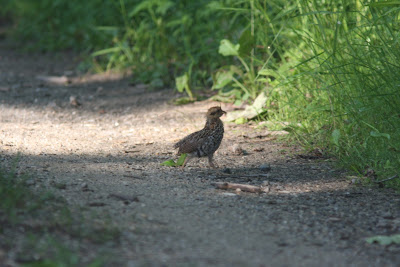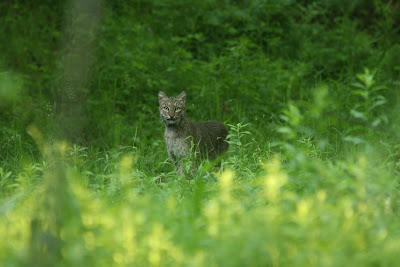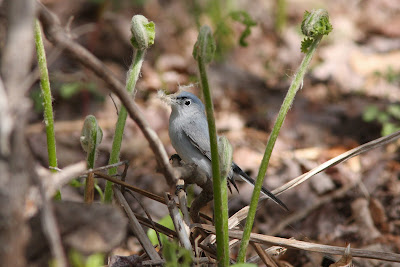 |
| American Redstart feeding young, Prescott Peninsula, Quabbin, MA, June 14, 2010 |
With the setting in of fall of 2011 the five year Massachusetts breeding bird atlas has now wrapped up and I thought I would take this time to reflect on some of the highlights the five seasons in the field provided me. This will be a relatively long post for me but hopefully interesting for those reading it.
First a little background of the breeding bird atlas here in Massachusetts. The first one was conducted during the years of 1974-1979. The second one began in 2007 and ended this year. It is a five year state wide project to get a snap shot of the various species of birds that breed throughout the state. It is a massive undertaking that requires a lot of effort of many volunteer birders to complete. In this area the many volunteers were coordinated by Mary Alice Wilson who did a fine job of getting the right people into the blocks and making sure we got the info entered into the state database. The entire state is split into blocks that are approximately 10 square miles. There are a total of about 1055 blocks statewide. Each block has a primary atlaster that is responsible for at least 20 hours of primary observation time (many block get much more time than that). Each block received a name and number that reflected the area it covered such as Winsor Dam 2 or Belchertown 5. Additional info can be found at
http://www.massaudubon.org/birdatlas/bbaportal/index.php
I had a total of four blocks assigned to me as the primary and another five as secondary with three of these on the restricted access Prescott Peninsula at Quabbin. Tom Gagnon was the primary on these blocks and I joined him on all his trips in there as well as taking many, many trips on my own. The total number of hours spent over the five years amounted to probably well over 1000 hours. The most productive blocks as far as overall species either breeding or suspected of breeding were Winsor Dam 3 and Shutesbury 8 which both had 91 species. I found a total of 136 species in the blocks I covered and was able to confirm breeding of 108 species. I had several records of state listed species breeding in the blocks I covered.
 |
| Red Crossbill feeding young, Prescott Peninsula, Quabbin, MA, June 3, 2009 |
 |
| Red Crossbills, Prescott Peninsula, Quabbin, MA, April 23, 2010 |
.JPG) |
| Red Crossbill, Prescott Peninsula, Quabbin, MA, April 30, 2010 |
The highlights were many and I will recount a few of the more memorable. As far as oddities one of the best was finding breeding Red Crossbills on Prescott Peninsula on a few years of the count. I first found them on the lower third of the peninsula in the only area I also had breeding Cerulean Warblers in a few seasons of the atlas. I had an adult feeding young there and managed a few photos for ID purposes. Over the next couple years I found evidence of breeding of Red Crossbills in other blocks on Prescott including males and females mating as well as additional recently fledged juveniles being fed. As far as what type of Red Crossbills I do not know but I had them feeding on red pines. Although there are other records of breeding Red Crossbills in the state over the years (Montague Plains WMA and pine barrens in the southeast part of the state) I believe the blocks on Prescott Peninsula were the only ones with breeding confirmed during the five years of the atlas. Many times I would have just a handful of birds but the best day I had was June 19, 2010 when I had 26 individuals with most in one large group.
 |
| distant shot of Canada Goose on nest in tree (old heron nest), Prescott Peninsula, Quabbin, MA, May 6, 2008 |
Another interesting sight was a Canada Goose that decided to take over a Great Blue Heron nest in a small pond. The bird was at least 15 feet above the water sitting in this nest. Certainly one of the strangest nest I have seen.
 |
| Barred Owl on nest (head and tail visible), Covey WMA, Belchertown, MA |
 |
| Northern Saw-whet Owl -juvenile in nest, Prescott Peninsula, Quabbin, MA, May 26, 2008 |
Another fun group of birds to try and find the nests of were owls. The best ones I found were a Northern Saw-whet Owl on Prescott Peninsula and a Barred Owl that used the same nest for several years at Covey WMA (the nest tree fell during a storm a few years ago). I also found a few juvenile Great Horned Owls and had Eastern Screech Owls in appropriate habitat during the breeding season. Besides the owls I also found some other nocturnal birds that were breeding in our blocks including American Woodcocks and Whip-Poor-Wills. The Whip-Poor-Wills seemed to have a stronghold in the southern third of the Prescott Peninsula and I would have double digit numbers on some of my evening trips in. Several times I had spectacular close views as the Whip-Poor-Wills came flying right next to us. Hearing several of them calling right near you in the pitch blackness of Prescott Peninsula was quite exciting.
.JPG) |
| Ruffed Grouse young, Prescott Peninsula, Quabbin, June 27, 2009 |
I had many breeding neotropic migrants during the years of the atlas as well as species such as Bald Eagle, Common Loons, Sharp shinned Hawk, Ruffed Grouse, Cooper's Hawk and others. It was always a thrill to find a bird gathering nest material or actually building a nest. I included a few of the many photos I got of this type of activity over the years of the atlas. It was fun to watch a nest be built, then have the birds sitting on the nest and then see the young develop and finally fledge from the nest. The time spent watching the various nests paid dividends in other ways as staying put and quiet led to some other wildlife sightings such as when I was viewing the American Redstart nest pictured above and I had the feeling I was being watched. I dropped my binoculars down, turned around and found a Bobcat thirty feet away looking at me.
.JPG) |
| Bobcat, Prescott Peninsula, June 7, 2010 |
In addition to the Bobcat I ran across a multitude of other wildlife such as Black Bear, Moose, Porcupine, various bat species, Mink, a Southern Bog Lemming (a life mammal for both Tom and myself on Prescott), lots of butterflies, other insects and a multitude of plant life.
.JPG) |
| Eastern Box Turtle (endangered species), Quabbin Park, May 3,2010 |
 |
| Leather Beetle, Prescott Peninsula, May 13, 2009 |
 |
| Gray Hairstreak, Prescott Peninsula, May 30, 2008 |
I could go on and on with the different experience I had while conducting this atlas and many photos to go along with the stories but I have to keep the post to a manageable size. I will say again it was fun and made you take a more critical look at the birds that you would come across from day to day. It will be unusual next spring to not be out there seeing what new species I can add to the various blocks I covered.
Here are some additional photos of various species either collecting nest material or on nests. The warblers and vireos were always some of my favorite subjects to find building nests and raising young. These as well as other neotropic migrants are fascinating in the long, perilous journeys they take from their breeding grounds here to their wintering areas in the Caribbean, central America or down to South America and back again each year.
 |
| Gray Catbird with nest material, Quabbin Park, May 23, 2010 |
 |
| Blue-gray Gnatcatcher gathering nest material from fern head, Quabbin Park, May 7, 2008 |
 |
| Chestnut sided Warbler on nest, Quabbin Park, June 13, 2008 |
 |
| Red eyed Vireo on nest, Prescott Peninsula, June 21, 2008 |
 |
Cedar Waxwing on nest, Prescott Peninsula, July 3, 2009
|









Thanks for a great post and heartfelt summary of BBA 2. It isn't hard to start atlasing, but it is hard to stop. We have a lot of ideas for other statewide monitoring efforts, and hope we get something in place as soon as next spring. Thanks again.
ReplyDeleteLarry, shouldn't the date for that saw-whet nest be May 26th not June 26th? Late June seems terribly late for nesting saw-whets in our area.
ReplyDeleteJames
The date for the saw whet should indeed be May 26th...good eye in spotting that...correction made.
Delete